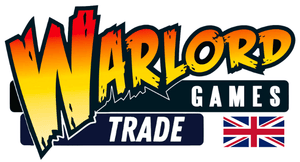Products
-
Khaki WebbingIn co-operation with Army Painter; Rapid Deployment has been developed as a great method to creatively, easily and accurately paint your miniatures! Designed for use on plastic, resin and metal figures. Each paint is of high quality, full of colour and ready for use...
-
King TigerThe Königstiger (officially named the Panzerkampfwagen Tiger Ausf. B or Sd.kfz 182) more commonly known as the ‘King Tiger’ or ‘Royal Tiger’ by Allied troops, was a development of the fearsome Tiger I tank. Its introduction to hostilities in 1944 caused significant problems for...
-
King Tiger-X with heavy rail gunWhilst production of the Tiger II remains limited and has been further curtailed by resources diverted to the heavy panzermech programme, the tank remains a highly potent vehicle. As rift-tech developments have led to newer and more potent weapon systems, the King Tiger has...
-
Knife BladesThe classic fine point blade is ideal for fine angle cuts, carving and etching, piercing, scoring, scraping, scribing and trimming. These blades work with a variety of materials: paper, card, plastics, balsa & foils. Ideal for crafters, modellers & professionals. Contains: 5 x Replacement...
-
Konflikt '47 British Starter SetMarch 1947. Europe is gradually emerging from it's most severe winter in living memory. Dug in through the winter, British and Commonwealth troops prepare to begin the last push into Germany. Setbacks the previous year are forgotten as new rift-tech weaponry arrives at the...
-
Konflikt '47 German Starter SetAs World War II continues beyond 1945, the battling countries have become even more desperate to develop new super weapons to give them a winning advantage. Exploiting new technologies revealed from the first nuclear explosions, the Axis and Allied forces quickly develop new tanks...
-
Konflikt '47 Japanese Starter SetJune 1947. The Imperial Japanese Army is consolidating its position after almost 16 years of war, first with China, then in a brief struggle with the Soviet Union and later against the US and British Commonwealth. With major gains on the Asian mainland and...
-
Konflikt '47 Soviet Starter SetMarch 1947. As Europe emerges from the worst winter in living memory the Soviet war machine is replenished and ready for action. 1946 was not the greatest year for The Motherland, although the German invaders were repulsed in their efforts to invade. After reverses...
-
Konflikt '47 US Starter SetAs World War II continues beyond 1945, the battling countries have become even more desperate to develop new super weapons to give them a winning advantage. Exploiting new technologies revealed from the first nuclear explosions, the Axis and Allied forces quickly develop new tanks...
-
Kriegsmarine E-boat flotillaThe Schnellboat or ‘E Boat’ as the British Admiralty called them, E for enemy, was a truly formidable beast, in many ways incomparable in detail to the other nation’s boats. In sheer size alone, the E boat was much, much bigger. Allied boats tended...
-
Kriegsmarine SquadThe men of the Kriegsmarine were often asked to do more than serve at sea. U-Boat and ship crews could be found in land actions in many theatres, wearing their trademark blue sailor’s uniforms or the grey-blue U-Boat leathers as they took the fight...
-
KV1/2 Plastic Box SetThe KV1/2 plastic box is absolutely crammed packed with the might of mother Russia: Enough plastic components to create one tank body and both complete turret variants (KV-1 turret and KV-2 turret)! A detailed construction booklet. A set of full-colour waterslide decals to allow...
-
L'OrientOrient was of the Océan-class of ships. These were a series of 118-gun three-decker ships of the line of the French Navy, designed by engineer Jacques-Noël Sané. Launched on July 20, 1791, she was originally named the Dauphin Royal, but having come into service...
-
Landsknecht missile troopsThe late 15th and early 16th centuries in Europe were defined by near-constant warfare. National ‘standing armies’ were unheard of and the ambitions of empires were reliant on the mercenaries they could afford to hire. Landsknechts were instigated by the Holy Roman Emperor, Maximillian...
-
Landsknecht Starter ArmyThe late 15th and early 16th centuries in Europe were defined by near-constant warfare. National ‘standing armies’ were unheard of and the ambitions of empires were reliant on the mercenaries they could afford to hire. Landsknechts were instigated by the Holy Roman Emperor, Maximillian...
-
Landsknechts PikemenThe late 15th and early 16th centuries in Europe were defined by near-constant warfare. National ‘standing armies’ were unheard of and the ambitions of empires were reliant on the mercenaries they could afford to hire. This box contains: Plastic components to make either 30...
-
Landsknechts with ZweihandersEurope in the late 15th and early 16th centuries was a place of almost constant warfare. With no organised national armies, battlefields were the domain of the mercenary companies of the day – chief amongst these were the colourfully dressed Landsknechts. Landsknechts were instigated...
-
Large Replacement Knife Blades x 5This large blade is perfect for making effortless cuts in rubber, foam, soft woods, plastic etc. It has a razor-sharp angle for cutting, carving & shaping as well as deburring and making light incisions.
-
Legio Aquila squadThe most fanatical and loyal soldiers within the ENR forces are trained and equipped along the same lines as the German SS Shocktroopers. They receive the best equipment and training but are expected to spearhead any counter-attacks against an Allied breakthrough along the Gustav...
-
Luftwaffe Field Division 88mm Flak 37Originally developed as an anti-aircraft weapon, the Flak 37 8.8cm (or Eighty-eight as it became known by Allied troops) had a high muzzle velocity to allow it to reach the higher ranges modern bombers were capable of at the time. This would make it an...






































